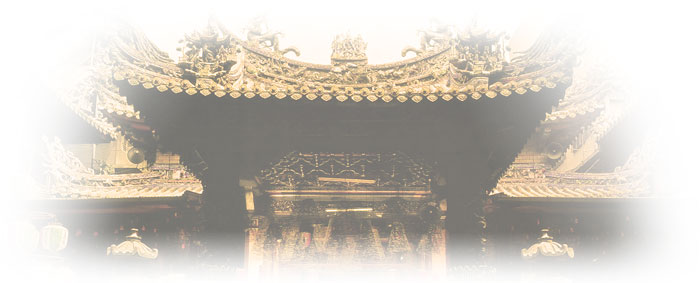 |
|
|
 |
A Predestined Relationship between Tamsui Basin and Mazu |
|
|
|
|
 |
| |
|
| |
| A Predestined Relationship between Tamsui Basin and Mazu |
| |
In the Qing period, the Tamsui River was indispensable to
the urban development along the riverside. Take a close look back
at the reclamation history of the Taipei Basin, and you will
discover that towns first appeared around the mouth area, such as
Bali and Tamsui, before gradually extending along the river to the
inlandXinjuang, Mankah, Songshan ( formerly known as Xikou),
Dadao Zheng, Shilin and Nangang. When early immigrants
traveled across the sea to Taiwan, they took with them incense ash
or the deities they worshipped in their hometowns in seek of
spiritual peace as well as ease the sense of insecurity felt in the
new environment and the fear that they might not be able to make
a living. To express their appreciation for the protection and
blessing from the deities, they continued to worship them in
Taiwan. As the number of believers continued to increase, temples
were also built up for consecration. During the Qing Court's rule
over Taiwan, shipping by boat was very important to the lives of
ordinary people. Therefore, marketplaces were often found in pier
areas along the river, and temples were built nearby because of the
crowd. While Mazu was esteemed as the navigation goddess, Mazu
temples were widely built and worshipped by the port. Most Mazu
temples have the frontdoor facing right toward the mountaintop
across the river for good geomancy ( fengshui ) and the protection
of the people on ships.
According to the local historical records, the development of
Mazu temples in northern Taiwan was indeed closely correlated in
time to the urban development of Tamsui River area. The Tienfei
Temple ( now known as the Taipei Guandou Temple ) was built in
Tamsui Guandou Gate during the regime of Emperor Kangxi of
the Qing Dynasty. The records also have it that another Tianhou
Temple ( now known as Xinzhuang Ciyou Temple ) appeared in
Xinzhuang during the regime of Emperor Yuengzheng. During the
regime of Emperor Qianlong, Tianhou temples in Mankah ( known
as Xinxing Temple, forerunner of Taipei Tianhou Temple ), Xikou
( now the Ciyou Temple in Songshan ), and Bali ( washed away
together with the city wall and streets in a flood during the regime
of Emperor Jiaqing ) were respectively built. Tianhou temples also
appeared on JiLan Street (now the Cicheng Temple in Shilin ) and
Dadao Zheng ( later moved toward the inland area and is now the
Cicheng Temple in Dadao Zheng ) during the regime of Emperors
Jiaqing and Tongzhi. During the regime of Emperor Guangxui (
142 years after Xinxing Temple was built ), the local government
established the Taipei Prefecture Tianhou Temple in the back street
of the Taipei Prefecture Office to express thanksgiving for the
efficacy of Mazu. ( The Taipei Prefecture Office was originally
located behind the National Taiwan Museum in 228 Memorial
Park, consecrating two Mazu statutes with gold plated on the face.
In 1913, however, the Japanese colonial government demolished
the temple for the construction of the Kogama Gentaroo Memorial
Hall. It was said that the bigger statue was carried to China by
President Tang Jing-song of the Taiwan Democratic Republic, and
the smaller one to the northern coast by a native of Sanji). In 2004,
Taipei City Government organized the Welcome Home Mazu event
at the 120th anniversary of Taipei's birth, clearly demonstrating that
the power of religious culture should never be overlooked even to
this day.
|
 |
|
|



